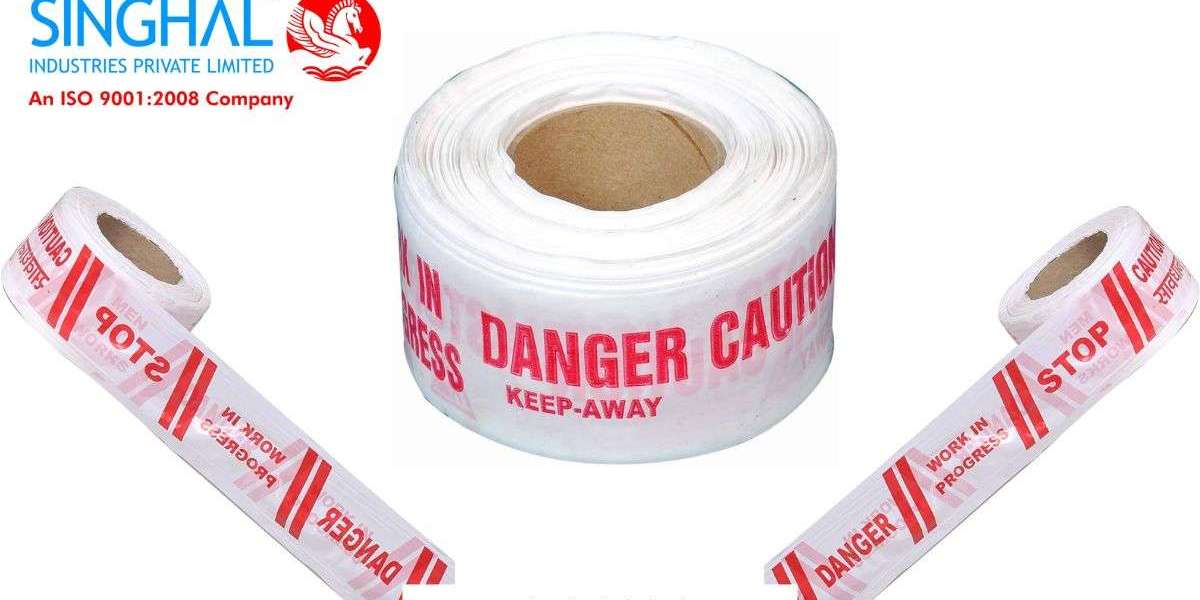In any environment, whether it's a construction site, a manufacturing plant, or even a home improvement project, safety is a top priority. Ensuring that hazardous areas are clearly marked and easy to identify is crucial for protecting workers and visitors from potential dangers. One simple yet highly effective tool used in safety management is the danger tape roll. This brightly colored, high-visibility tape plays an essential role in marking dangerous areas, restricting access, and signaling to others that caution is needed.
In this article, we will explore the importance of danger tape rolls, their various uses, and how they help in enhancing workplace safety. We will also discuss electrical warning tape as a specialized version of safety caution tape, and how it is vital in managing electrical hazards. Finally, we will provide guidance on choosing the right tape for your specific needs.
What is Danger Tape Roll?
A Danger tape roll, often referred to as safety tape or caution tape, is a strong, durable, and highly visible tape that is commonly used in workplaces, construction sites, and various hazardous environments to indicate danger or restricted access. Typically made from polyethylene, PVC, or other flexible materials, these tapes come in various colors such as yellow, red, or black and are often printed with bold warning messages like “DANGER,” “CAUTION,” or “AUTHORIZED PERSONNEL ONLY.”
The primary function of danger tape rolls is to act as a visual deterrent, alerting people to the presence of potential hazards. It helps ensure that hazardous areas are easily identifiable, preventing accidents and improving the overall safety of the environment. Whether you're trying to keep people away from a construction zone or warning workers about exposed electrical wires, danger tape plays an essential role in preventing mishaps.
Types of Danger Tape Rolls
There are different types of safety caution tapes, each designed for specific purposes. Some of the most commonly used varieties include:
General Warning Tape: This type of tape is typically yellow or red with bold, black text stating "CAUTION," "DANGER," or "WARNING." It is used to mark hazardous areas where individuals should be extra cautious or refrain from entering. General warning tape can be found on construction sites, warehouses, and even in public areas like shopping malls to prevent access to dangerous zones.
Electrical Warning Tape: Often designed with bold stripes or a specific color pattern, Electrical warning tape is used in areas where electrical hazards exist. The tape alerts workers and passersby about the presence of exposed electrical wires, cables, or equipment that may pose a shock risk. This type of safety caution tape is vital in preventing electrical accidents and ensuring the proper handling of electrical components during repairs or installations.
Barrier Tape: This tape is typically used to create a physical barrier around construction sites, accidents, or hazardous zones. Barrier tapes often feature bright colors like red or yellow with messages like "DO NOT ENTER" or "KEEP OUT." These are commonly used for crowd control, securing construction zones, and preventing unauthorized access to dangerous areas.
Fire Safety Tape: A specific variant used in areas where fire hazards are prevalent, this tape is often red with black text indicating fire-related risks, such as flammable materials or restricted fire exit routes. It helps highlight fire hazards, ensuring that employees or workers can take the necessary precautions to prevent a disaster.
Importance of Danger Tape Roll in Workplace Safety
The use of a danger tape roll is critical in maintaining workplace safety and reducing the risk of accidents. Here are some reasons why this tool is indispensable in any safety plan:
Visibility and Awareness: The bold colors and clear warning messages printed on the tape are highly visible, even from a distance. This helps in alerting workers, visitors, and the general public to the presence of hazards. For example, bright yellow or red tapes can easily catch someone's attention and warn them to avoid a dangerous area or to take extra precautions.
Clear Signaling: Using danger tape ensures that hazardous areas are clearly marked, reducing confusion and preventing accidents. Whether it's a construction zone, electrical equipment, or an area containing toxic substances, the tape sends a clear message that caution is needed.
Prevent Unauthorized Access: Danger tapes help mark restricted areas and prevent unauthorized access to hazardous zones. This is especially important in industrial settings or environments with heavy machinery, toxic chemicals, or ongoing construction activities. By using a danger tape roll, businesses can effectively control access to potentially dangerous areas, ensuring only qualified personnel enter those spaces.
Cost-Effective Safety Tool: One of the biggest advantages of using Safety caution tape is its affordability. It is a low-cost solution that provides immediate results in enhancing safety. The tape is easy to apply, reusable, and can be used in a variety of environments, making it a highly cost-effective option for maintaining safety.
Easy to Use: Danger tape rolls are extremely easy to install and can be applied quickly, saving time on preparation and setup. They can be taped around any area or equipment that needs to be marked as a safety risk, allowing businesses to quickly take action when new hazards arise.
Choosing the Right Danger Tape Roll
When selecting a danger tape roll, it's important to consider the following factors to ensure you are using the right tape for your specific needs:
Material Strength: Ensure the tape is made from durable, weather-resistant materials that can withstand environmental conditions such as rain, heat, and wind. Look for high-quality polyethylene or PVC tapes that offer strong adhesion and durability.
Message and Visibility: Choose tape with bold, easy-to-read messages. Whether you need "DANGER," "CAUTION," or "KEEP OUT," the tape should be clearly visible and legible from a distance.
Color Coding: Different colors are often used for different purposes. Yellow is commonly used for general warnings, while red indicates high danger. Black and yellow stripes are frequently used for electrical hazards. Choose the right color based on the type of hazard you are trying to indicate.
Length and Width: Ensure that the tape length and width suit your application. Longer rolls are typically used for marking large areas or construction sites, while shorter rolls may be sufficient for small equipment or single-point hazard areas.
Frequently Asked Questions (FAQs)
1. Can danger tape be used outdoors?
Yes, danger tape is designed to be weather-resistant and can be used outdoors in all types of weather conditions, including rain and wind. It is durable enough to withstand the elements and continue providing visible warnings for hazardous areas.
2. Is electrical warning tape required in every workplace with electrical hazards?
Yes, electrical warning tape is crucial in any workplace where electrical hazards are present. It helps to clearly mark areas where employees should take extra precautions when dealing with electrical equipment or cables. This tape reduces the risk of electrical accidents and ensures the safety of workers.
3. Can I reuse safety caution tape?
While danger tape rolls are designed to be durable, they are often intended for single-use applications, especially if they have been exposed to dirt or damage. However, some tapes can be reused if they are in good condition and still adhesive, especially in low-risk environments or for marking temporary hazards.



